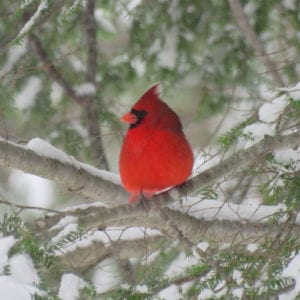
Female Northern Cardinal by Jayne Winters

Photo by Jayne Winters
Northern Cardinal
Cardinalis cardinalis
Cool Fact: Or in this case…”cold” fact—Cardinals don’t migrate or fly south for the winter like most other birds. They will shiver and tense their muscles to generate heat, having the ability to drop their body temperature 3 – 6° in order to survive cold temperatures.
Named by early European settlers because of their resemblance to the red robes and tall, pointed caps worn by the high-ranking bishops of the Roman Catholic Church, the male Northern Cardinal’s vivid red color and distinctive crest have made it one of our most popular birds. First designated as Kentucky’s state bird in 1926, Illinois, Indiana, North Carolina, Ohio, Virginia, and West Virginia have also assigned it that title.
Northern Cardinals sing more than 24 different songs and during the breeding season, males may sing 200 or more per hour. The females are among the more vocal of female North American songbirds. In addition to courting melodies, her singing later tells her mate when to bring food and when to stay away. Her warning call keeps the male’s visits to a minimum, so his flashy color doesn’t expose her or the nest to predators. A male cardinal will aggressively defend his territory, chasing away intruders and often mistakenly attacking his own reflection in car windows and mirrors; females also show aggressive behavior.
Northern Cardinals were considered rare in 1929, found mostly in the southern region, but by 1955 records indicated they were “pushing northward,” likely due to climate change, the loss of dense forest to agriculture and suburban uses, as well as the increased use of birdfeeders. Today its range extends from Maine to Minnesota to Texas, south into Mexico, and north into Canada, from Ontario to Quebec, New Brunswick, Nova Scotia, and Cape Breton Island. Its habitat includes woodlands (where dense cover is mixed with open areas), brushy fields, wetlands, and suburban areas.
Now a common species across much of Maine, breeding was first documented in 1969 in southern Maine. During 2018, nesting records expanded east to Lubec and north to Presque Isle. The US population is estimated to be more than 90 million birds and is in no current danger of extinction.
Their diet is varied, ranging from seeds, berries and wild fruit to insects, including beetles, grasshoppers, caterpillars, ants, spiders – even snails; young birds are fed almost entirely on insects for a strong diet of protein and fat while they’re growing. Although they prefer foraging on the ground, cardinals will readily come to bird feeders, where they favor black oil sunflower seeds. Other diet items include corn, oats, the blossoms and bark of elm trees, and maple sap from holes made by woodpeckers and sapsuckers. Their dietary flexibility allows them to remain in the same area year-round. They join mixed-species flocks during the winter to find food and for safety.
The Northern Cardinal is a mid-sized perching songbird with a body length of 8 – 9” and a wingspan of 9 – 12”. It weighs 1.2 – 2.3 ounces, averaging 1.58 ounces; the male is slightly larger than the female. The adult male is a brilliant crimson red color with a black face mask over the eyes, extending to the upper chest. The color is duller and darker on the back and wings. The less flashy female is beautiful nonethe less, a reddish olive, with a less defined gray mask around the bill, and a reddish tint on the wings and crest. Both sexes have pronounced raised crests and bright coral-colored, cone-shaped beaks.
Cardinal pairs generally stay together year-round, but are not necessarily monogamous. About 20% of mated pairs separate each year, but most stay together for several breeding seasons. Nesting begins by late April, with males and females gathering materials. The nest is built by the female in a well-concealed area, such as dense shrubbery or a tree 3-10’ off the ground. It takes three to nine days to build and has several layers: twigs covered in a leafy mat, lined with bark, grasses, stems, rootlets, and pine needles. Once completed, the nest is 2-3” tall and 4” across. Cardinals do not usually use their nests more than once.
The female lays two to five eggs, which are white to pale blue or green, speckled with brown, gray, and purple. Incubation is usually by the female alone for 9 – 11 days; the male delivers food to her during that period. Once the young hatch, both parents feed them (often eight times an hour!) for about two weeks, until they fledge. The male continues to feed them while the female starts working on her next nest—pairs have two to three broods a year. Juvenile coloring is similar to the adult female, but they don’t have the red-orange bill or defined colors until they are almost fully mature.
The oldest wild cardinal banded by researchers lived over 15 years; the oldest captive was 28½ years old; annual survival rates for adults are estimated at 60–65%. Like many other birds, the Northern Cardinal is flourishing in human-altered habitats. Although now common and widespread, it’s vulnerable to the same threats as other birds, particularly predation by cats, wildlife, the use of pesticides and collisions.
In Christianity and Native American cultures, cardinals are seen as messengers from the spirit world, bringing protection and comfort to those in need, especially during grief and loss. Seeing a cardinal, especially during the winter, sends a message of hope and beauty during cold, dark and dismal days. Representing love, unity and the promise of brighter days ahead, “When cardinals are here, angels are near.”
“Cool Facts”
* A group of Northern Cardinals is called a “college,” “conclave,” or “Vatican.”
* Like flamingoes, the foods cardinals eat determine the feather color density. Pigments from fruit enter the bloodstream and crystallize in the feather follicles. If access to berries is limited, color hue will gradually fade.
* Cardinals don’t migrate or fly south for the winter like most other birds. They will shiver and tense their muscles to generate heat, having the ability to drop their body temperature 3 – 6° in order to survive cold temperatures.
* The Northern Cardinal was a popular cage bird in the 1800’s, but is now protected in the U.S. by the Migratory Bird Treaty Act.
* Not all Northern Cardinals are red, some are yellow. This is caused by a genetic mutation in which the enzyme that converts yellow pigments in its food is missing.
* Cardinals with one side red and another olive have been documented in several states, the most recent in PA in 2021. Biologists theorize that: 1) two separate embryos, one female and one male, fuse during development; 2) the adult female produces an egg with both sex chromosomes which is fertilized by two separate sperm; or 3) a fertilized ovum divides with one side male and the other female.
—Written by Jayne Winters – November 18, 2025
Resources:
https://en.wikipedia.org/wiki/Northern_cardinal
https://abcbirds.org/news/female-cardinals/
https://ebird.org/atlasme/about/northern-cardinal
https://www.audubon.org/magazine/10-fun-facts-about-northern-cardinal
https://indianapolis.wbu.com/cardinal-facts
https://www.birdsandblooms.com/birding/birding-basics/cardinal-bird-facts/
https://www.mentalfloss.com/article/72702/10-crimson-facts-about-cardinals
https://www.milanomonuments.com/blog/the-symbolism-of-cardinals-in-grief-and-cultures










